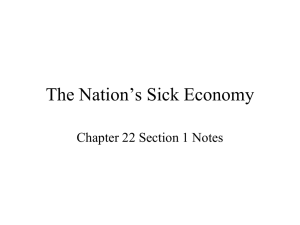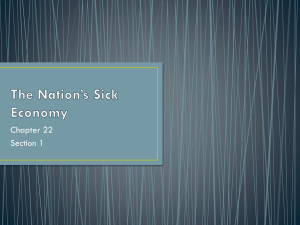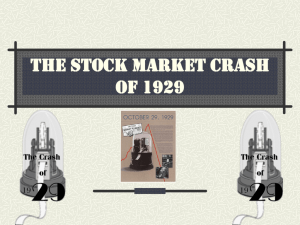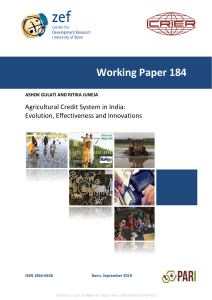Name: _______________________________ USVA History Chapter 22.1 – The Nation’s sick economy
advertisement
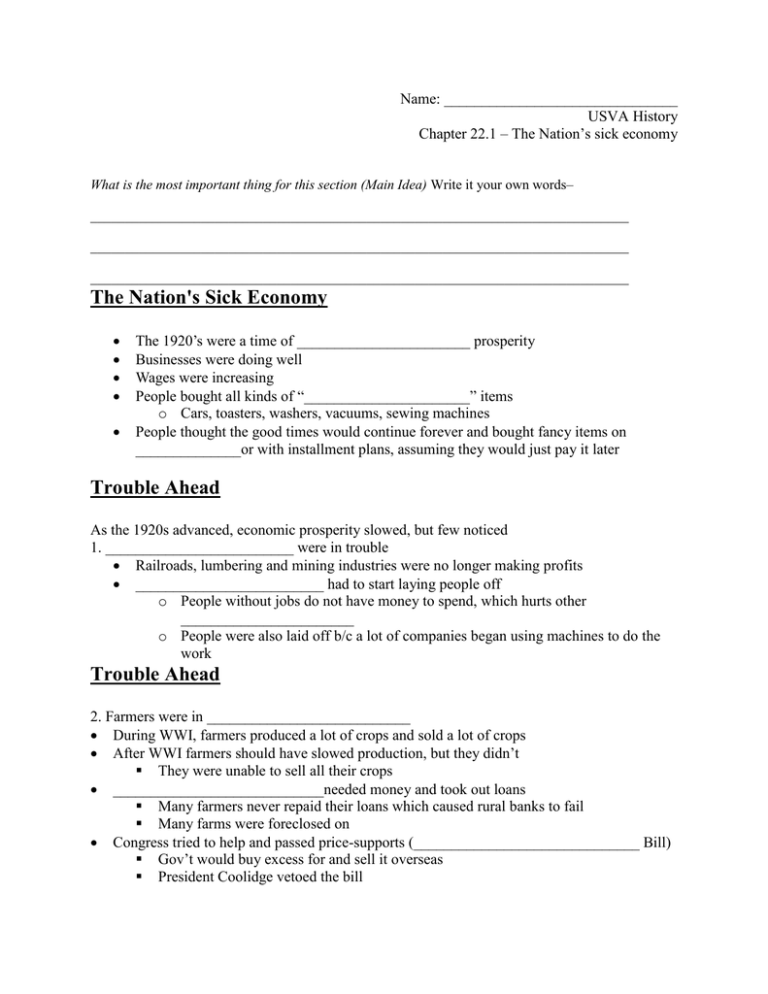
Name: _______________________________ USVA History Chapter 22.1 – The Nation’s sick economy What is the most important thing for this section (Main Idea) Write it your own words– ______________________________________________________________________________ ______________________________________________________________________________ ______________________________________________________________________________ The Nation's Sick Economy The 1920’s were a time of _______________________ prosperity Businesses were doing well Wages were increasing People bought all kinds of “______________________” items o Cars, toasters, washers, vacuums, sewing machines People thought the good times would continue forever and bought fancy items on ______________or with installment plans, assuming they would just pay it later Trouble Ahead As the 1920s advanced, economic prosperity slowed, but few noticed 1. _________________________ were in trouble Railroads, lumbering and mining industries were no longer making profits _________________________ had to start laying people off o People without jobs do not have money to spend, which hurts other _______________________ o People were also laid off b/c a lot of companies began using machines to do the work Trouble Ahead 2. Farmers were in ___________________________ During WWI, farmers produced a lot of crops and sold a lot of crops After WWI farmers should have slowed production, but they didn’t They were unable to sell all their crops ____________________________needed money and took out loans Many farmers never repaid their loans which caused rural banks to fail Many farms were foreclosed on Congress tried to help and passed price-supports (______________________________ Bill) Gov’t would buy excess for and sell it overseas President Coolidge vetoed the bill 3. Consumers had less money to spend As businesses failed, wages were cut and people could not spend money on “extra” items Since nobody was buying, more businesses ______________________________, causing more _______________________________, which caused even less money to be spent in stores 4. Living on _______________________ People were living above their means People could not afford to buy items out right so they paid for them on credit and assumed they would pay it back later Credit Cards Installment Plans -paying off the total cost in _____________________ payments Buying Stocks ___________________________________- many wanted to invest in the stock market, but could not afford to pay the full amount of the stock so they borrowed from a broker (took out a ________________ to pay for it) Many couldn’t pay back the full amount of their loans or were so strapped for cash they couldn’t spend money on other items, which hurt other businesses, causing more people to become unemployed 5. _____________________________ distribution of wealth Rich got richer, poor got poorer Most earned less than $2,500 a _____________________ Had no ___________________ Relied on credit Hoover takes over 1928- ___________________________ wins the election o Little focus on the _____________________ o People think the good times will continue People believed investing in the stock market was the key to __________________ o Dow Jones Industrial Average was high (Bull Market) o People began engaging in ___________________________ o Buy low, sell high o Make quick money o Many didn’t realize the risk, thought the market would continue to increase People began buying ________________________ on the Margin o Many couldn’t afford to pay the full amount of the stock so they borrowed money from a broker o Makes the market appear ____________________ than it actually is o If Stock price declines, people have no way of paying off the loan The government did little to discourage excessive ________________________ The Stock Market Crashes By early September 1929 many began to question the strength of the market o People began ___________________________ their stocks ____________________________________- October 29, 1929 o Confidence in the market collapsed o People began selling their stocks for pennies ___________________________ stocks sold o Could not pay back their ________________________ Caused banks to close, by November investors had lost ___________________________________ The Great Depression Begins 1929-1940- time period where the economy plummeted and unemployment rose o Banks Failed o People panicked and went to their banks demanding their money What is this called? ____________________________________________________________ Many banks ______________________________ the money in the stock market and did not have the money to give back Many lost their entire life savings The government did not _____________________bank accounts Today, FDIC up to $250,000 By 1933-11,000 of 25,000 banks failed Businesses Failed o The _____________________________________________ (total output of goods) was cut from 104 billion to 59 billion o ___________________________________ businesses failed Unemployment Rose o From 3%-25% Draw a line through the normal unemployment rate The Great Depression The Depression _________________________________ throughout the world o European nations were still trying to recover from _________________________ o ____________________________ was the center of the financial world o Many nations relied on the US for loans o Many also relied on the US to ____________________ goods o US passed the __________________________________________________ Act Highest protective tariffs in US History Designed to protect American farmers and businesses It failed It stopped Europeans from buying _______________________ goods Increased _____________________________________ encouraged other nations to pass similar tariffs
